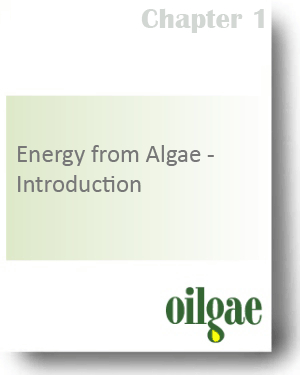Chapter I - Energy from Algae
This page provides details of the chapter I, from the Comprehensive Oilgae Report. You can purchase this chapter alone using the payment button provided below.
Who should buy this chapter?
This chapter gives the reader a clear picture about algae and its potential as a fuel source. People who wish to know the basics of algae fuel can buy this chapter.
Introduction
Algae are an extremely important species. For one, they produce more oxygen than all the plants in the world combined! For another, they form an important food source for many animals such as little shrimps and huge whales. Thus, they are at the bottom of the food chain with many living things depending upon them. With the recent research and interest into using algae for producing biofuels, they have the potential to become even more important.
In the right conditions, algae can harness the energy of sunlight very effectively, allowing them to double their mass very quickly. This chapter deals with the amount of energy and energy products one could obtain from algae.
List of Contents
- Algae
- Energy from Algae
- Oil and Biodiesel from Algae
- A Whole Range of Energy Products
- History & Current Status of Energy from Algae
- Algae Energy & Alternative Energy
- Big Challenges & Big Payoffs
- Energy "Products" from Algae
- Biomass Composition
- Conventional Processes in the Fossil Fuel and Related Industries
- The Energy Product Basket from Algae
- Upstream and Downstream Processes
- Determining the Optimal "Energy Product"
- Algae to Energy – Summary of Processes for Each Energy Product
- Trends & Future of Energy from Algae
- Factoids
Key Takeaways from the chapter
- Algae represent the third generation feedstock for biodiesel, with much higher yields than second generation crops.On lipid content alone (in terms of % of lipid content by dry weight), algae are only as good as biomass from most other oil crops. Where algae score over all other oil crops is in the biomass yield for similar areas.
- Algae yields could reach a high of 50 T of biodiesel per hectare year against 2 T for competing feedstock such as Jatropha.
- Pilot projects suggest that algae could provide over 10,000 gallons of biodiesel per hectare per year.
- Oil yields per unit area from algae can be even further increased, and it is one of the most researched topics currently.
- Making biodiesel from algae oil is similar to the process of making biodiesel oil from any other oilseed, and thus can quite possibly use the same conversion processes to produce biodiesel.
- The traditional method of producing biodiesel from algae is transesterification.
- There could be some challenges in converting algae oil into biodiesel using the transesterification process owing to the high FFA of algae oil.
List of Tables
- Algae Energy & Alternative Energy
- Revenues of Top 5 Oil Companies (2009, US$ Billions)
- Summary of Processes for the Main Energy Products from Algae
List of Figures
- Lipid Content of Algae
- Paths to the Various Energy Products from Algae
We are no more selling this report. |
|
No of Pages : 13 Last Updated : June 2010 Price : 100 US $ |
Related Chapters from the Section I – Concepts & Cultivation

